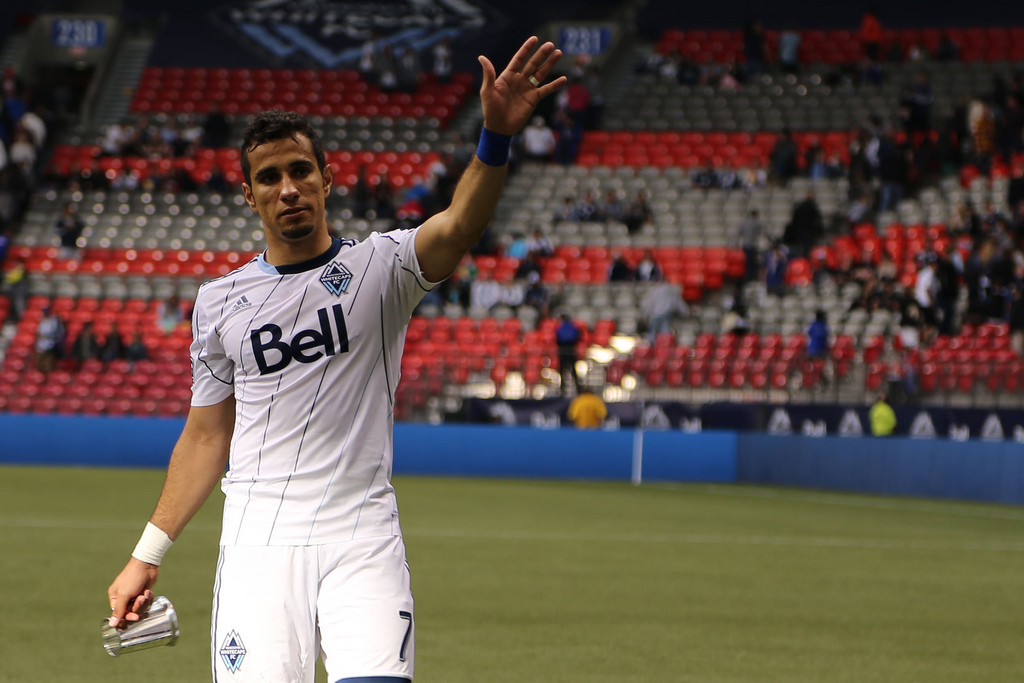
Camilo’s 22 goals in 2013 didn’t help the Whitecaps make the playoffs and now that he’s gone, the club must concern itself with scoring when it counts rather than scoring in his absence. (Photo Vancouver Southsiders/flickr)
It’s been a long, dark off-season for the Vancouver Whitecaps, but the good news is that none of the blunders, miscues or departures have made the team’s biggest problems worse.
Nothing has stung as stung as bad as Camilo, the league’s top scorer in 2013, who ducked a club-triggered contract option and appeared in another team’s jersey in a successful attempt to force a move to Mexico. Whether you blamed Camilo for being an amoral mercenary or the front office for not working harder to make sure the man who wore a Golden Boot was happy (or both!) it was an emotional tragedy that seemed impossible to recover from.
It’s not the only time the five-person panel of front-office staff led by Bob Lenarduzzi at the helm has been left looking poor this winter. It was clear the club wanted former U.S. national team manager Bob Bradley for Rennie’s spot. He passed, forcing the Whitecaps to very publicly settle for their second choice, the able and patient assistant manager Carl Robinson. Usually-moribund Toronto FC brought in two stars in the same week while YVR’s international arrivals section was devoid of blue and white. It had appeared, briefly, that first-round draft pick Andre Lewis was, in fact, committed to the New York Cosmos before the league clarified that they had arranged a deal with the NASL club.
I am here to tell you that none of this matters. Camilo’s unreliability is as legendary as his brilliance, the Whitecaps will sign a new designated player or they won’t and Lewis, if desired, will be prised from the Cosmos, unless he isn’t. Carl Robinson is as well positioned as any man to deal with the only problem that matters for the team, which can only be solved in the pre-season: the team’s inability to take and hold games in key situations.
The intensity of despair that surrounds Camilo’s departure is based on two assumptions. The first is that Camilo somehow took his 22 goals with him when he left, and the second is that replacing those goals is an unlikely task that is necessary for the team to succeed.
The reality is that the value of goals is fluid. Camilo and Eric Hassli combined for a talismanic 22 league goals in the Whitecaps’ 2011 last-place finish (next on the scorers list: Alain Rochat with three) and scored seven (five and two, respectively) the next year. The Whitecaps “lost” 15 goals then, but five >3 goal scorers (Sebastien Le Toux, Darren Mattocks, Barry Robson, Gershon Koffie and Dane Richards) scored 20 goals between them in 2012 and the club made the playoffs.
That team scored 35 goals; next year’s edition scored 18 more times and missed the playoffs by two places. They only allowed four more goals. The point I’m making is that none of these numbers matter. They’re a good indicator of individual contribution, and indeed Camilo was important: his boot sealed that 2-2 draw against Portland and kept the Whitecaps on course to win their first Cascadia Cup since 2008.
But goals alone do not deliver a playoff spot. Secondary scoring was fine in 2013, with Koffie, Mattocks, Kenny Miller, Kekuta Manneh and Jordan Harvey (!) contributing 24 goals between them. But the team lacked a cohesiveness and consistency that harmed them at key moments, combining a narrative of early failure with an inability to hold key results. The hypothetical nine points lost from winning and drawing positions in the last 20 minutes would have put them in a tie for first place in the West.
That Camilo’s last game as a Whitecap saw him score a hat trick at home against the Colorado Rapids one game after the Rapids eliminated them from the playoffs on the road with a 77th minute goal tells the whole story of the team’s season. A sorry August 14 road loss to the Rapids when the Whitecaps were in the playoffs by two points and four places was another opportunity lost that typified the club’s troubles.
Intangibles like organization and desire can’t be pinpointed and diagnosed, but instability on the backline started with captain Jay DeMerit’s Achilles rupture injury in the home-opener that kept him out for most of the season. His age and injury history make him a question mark, but he is a leader in the locker room and his return for the new season is a positive omen. Brad Rusin, Andy O’Brien and Jonny Leveron wavered in and out, and the trade of Alain Rochat remains a puzzling question mark that kept the defensive unit in constant flux.
This is why I don’t think there’s a lot of pressure on draftee Andre Lewis, but I have high hopes for Christian Blake. We get a new influx of young, talented attackers that need time to grow into the league every year. But if Blake can come under the wing of DeMerit and O’Brien and can help add energy on defense without getting hurt, that will work wonders. A replacement for Young-Pyo Lee must also be found.
The cohesion of the team makes the pre-season camp vital. Can the well-liked Robinson succeed in forming a indefatigable unit where his boss couldn’t? (First, let him diverge from Rennie’s path by ditching the suit. It didn’t seem to fit him well at the draft.) It remains to be seen, but this is a matter of chemistry that you can’t predict. Let’s see how it works.
Offensively, the only thing that matters is picking people who can deliver when it really counts. Let it sink in that Jordan Harvey scored more goals than Darren Mattocks and the need for a reliable striker who can deliver results is obvious. If the Whitecaps have got $1.5 million for Camilo, that plus the extra breathing room in salary cap helps improve their prospects in the transfer market dramatically. In MLS, this decision can never be taken lightly.
In the end, you could never predict whether Camilo would score 22 goals or 5 or whether he’d end up in training camp when he had a theoretically valid contract. That’s not going to put you in the playoffs, and though it seems a lot of these off-season headlines won’t either, the path back to the MLS Cup hunt starts only one place: on the training pitch next Monday. Let’s hope for greener pastures.
